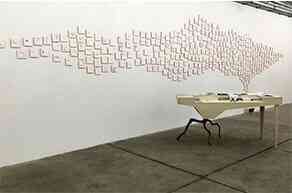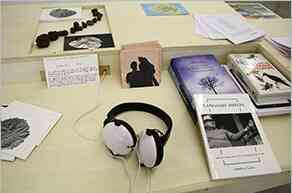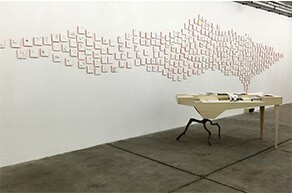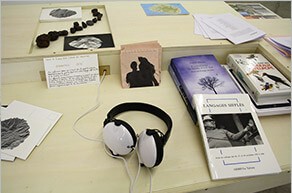Julie Michel
Julie Michel is an Astérides Resident in 2016. The archives of Triangle-Astérides do not allow for the determination of the exact dates or the duration of this residency in 2016.
“My work gradually establishes problematic landscapes that allow for thinking, bringing into existence, and feeling alternative relationships to language and perception, by multiplying modes of translation.
The research I am currently conducting as part of the BreathSound project seeks to rub the question of language and sound against that of the environment, territory, and landscape, and to explore their interdependent relationships.
It unfolds in various forms: live sound creation, video, installation, drawing. A creative (audio) documentary is currently in production (Les siffleurs dans l’espace).
At the outset, there was the encounter with Silbo, the whistled language of the volcanic island of La Gomera in the Canary Islands. Deep valleys (barrancos), bodies subjected to the conditions of a mountainous geography (Calima).
Knowing that spoken words can only be understood within a reasonable distance between two speakers, how, despite the distance and considering the cost of moving around the island, can one manage to communicate? By modulating the intonations that rhythm spoken language through digitization. Literally. The use of fingers enables the production of a whistle powerful enough to be heard and understood across several kilometers. The original language—its vowels, consonants, the song of its words and phrasing—is recoded. Silbo is not a language, but rather a particular and localized modulation of the Spanish language. Now officially taught in schools on the island, it was once used by farmers to communicate across long distances.
Silbo also places communication between humans within a frequency range also occupied by other beings… A child encountered in La Gomera recounted that some whistlers, believing they were being called by others, were actually being deceived by blackbirds. Expanding this anecdote, opening it to other practices, other skills, and setting up devices that reveal the relationships between birds and humans. Working around objects that mediate these relationships (Alain Carpentras, bird call maker, Atelier des Castors, Sorgues). Complicating the links between music and language and blurring the boundaries between human music and animal music (OiseauTale). Questioning the premise that language is unique to humans in order to open it up to other kingdoms, to other interspecies relationships. Raising the question of the importance of interactions between the human world and the non-human world, which, when they cease to occur, lead to the impoverishment or even destruction of both worlds.
Modulation and interference are key motifs of the project. They aim to activate a certain ‘ecology of the senses’ (D. Abram) that renews and enriches the interaction between these worlds. This ecology likely also involves a redistribution of the relationships between the visual and the auditory .(Jeu1) and the exploration of synesthetic relationships between these two perceptual modes ((birds)flock).
In parallel, within the collective NightOwl** founded with Olivier Crabbé, I am conducting research and dissemination work around the oeuvre of Knud Viktor, a Danish artist often referred to as one of the ‘pioneers’ of sound ecology. This work led to Fais attention au sol sur lequel tu marches, a kind of sound fanzine/mix-edit that brings his work and approach to life. This listening practice is part of a broader research project including the organization of a seminar at ENSA Bourges and the writing of a radio documentary project that will focus on the unique—technical, artistic, and ‘ethological’—methods developed by Knud Viktor to deploy his work, as well as the relevance and importance of that work today. As we began to do with Fais attention au sol sur lequel tu marches, we will borrow the notion of ethopoetry (Vinciane Despret) to navigate all these dimensions and attempt to convey what seems to us to be one of the great originalities of his work: the way it merges, in a single gesture, an in-depth ‘naturalist’ exploration of a territory with the poetic translation/expression of the events that populate it.”
– Julie Michel, 2016
Julie Michel’s work is on display during the exhibition Currently in residence #2 - Fortunate coincidences, 2016.



